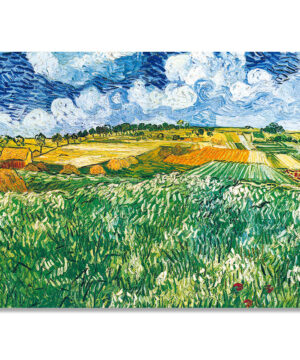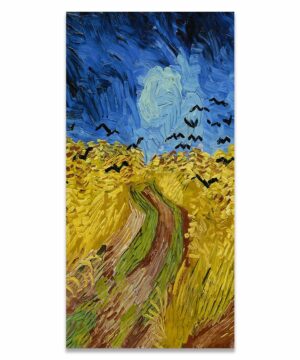Vincent van Gogh, often referred to as the ‘painter of the sunflowers’, had a strong affinity towards nature. It was nature, in which he found not only peace and solace but also a deep inspiration for his art. Therefore, he saw nature and art as inseparably linked. In one of Vincent van Gogh’s letters to his brother Theo, the artist wrote: ‘…if I felt no love for nature and my work, then I would be unhappy.’ Even if he did not choose tulips for his still lives like the sunflowers, he chose to paint flower scenes in his world-renowned gardening paintingPainting is a fundamental form of visual art that has been practiced for thousands of years. It involves applying pigment to a surface such as canvas, paper, or a wall. Painting can be explored through various styles, techniques, and mediums, each offering unique possibilities for expression and creativity. Historical Background • Ancient Beginnings: The history of painting dates back to More “Bulb Fields”. His expressive and emotive use of vivid colour and the brisk application of impastoed paint makes the scene almost tangible.
Where is the picture “Bulb Fields” today?
Vincent van Gogh’s original paintingPainting is a fundamental form of visual art that has been practiced for thousands of years. It involves applying pigment to a surface such as canvas, paper, or a wall. Painting can be explored through various styles, techniques, and mediums, each offering unique possibilities for expression and creativity. Historical Background • Ancient Beginnings: The history of painting dates back to More “Bulb Fields” is part of the permanent collection of the National Gallery of Art, Washington D.C.
What’s in it?
In his tulip paintingPainting is a fundamental form of visual art that has been practiced for thousands of years. It involves applying pigment to a surface such as canvas, paper, or a wall. Painting can be explored through various styles, techniques, and mediums, each offering unique possibilities for expression and creativity. Historical Background • Ancient Beginnings: The history of painting dates back to More “Bulb Fields”, van Gogh depicts colourful flower beds in rectangular alignment in bright pastel colours of blue, yellow, pink, and red under a cloudy sky. The light is dim, as the sun is about to set. Like in his other landscape paintings, van Gogh applies a perspective of a very low vantage point, that he experimented further in the years to come. While the lower part of the picture is dominated by the flower beds, the upper part is dominated by civilizational features of the settlement, including a farmer walking in between the fields, checking the flowers, two houses framing the fields, and further village structures in the far back.
What’s the context?
Van Gogh painted his tulip paintingPainting is a fundamental form of visual art that has been practiced for thousands of years. It involves applying pigment to a surface such as canvas, paper, or a wall. Painting can be explored through various styles, techniques, and mediums, each offering unique possibilities for expression and creativity. Historical Background • Ancient Beginnings: The history of painting dates back to More “Bulb Fields” in 1883 towards the end of a two-year-long stay in The Hague. The artist had warm feelings towards the city on the western coast of the Netherlands, where he stayed twice for longer periods, each time being strongly inspired artistically.
Chatter and Prattle
- Van Gogh was dependent on financial assistance from his brother Theo, who supported his devotion to paintingPainting is a fundamental form of visual art that has been practiced for thousands of years. It involves applying pigment to a surface such as canvas, paper, or a wall. Painting can be explored through various styles, techniques, and mediums, each offering unique possibilities for expression and creativity. Historical Background • Ancient Beginnings: The history of painting dates back to More. However, when the artist became involved with a pregnant prostitute called “Sien” whom he had met on the street, tensions arose between the brothers. Van Gogh saw himself forced to move out of The Hague to live more economically in the Drenthe countryside, leaving his beloved Sien behind.
- Even if tulips weren’t the most prominent flowers in van Gogh’s art, there is a tulip named after him. Reddish-brown in colour, the ‘Vincent van GoghVincent van Gogh (1853 – 1890) is one of the renowned Post-Impressionist artists, best known for his striking use of colour, emphatic brushwork, and contoured forms. As a son of a pastor, the Dutch artist war brought up in a religious and cultured atmosphere. After working unsuccessfully as a clerk at a bookstore, as a salesman, and as a preacher More tulip’ grows to a height of about 50 – 60 cm.
Recommended Readings:
This article may contain compensated links. Please read Disclaimer for more info. As an Amazon Associate, I earn from qualifying purchases.
Ingo F. Walther et al. (2020): Van Gogh. The Complete Paintings
Vincent Van GoghVincent van Gogh (1853 – 1890) is one of the renowned Post-Impressionist artists, best known for his striking use of colour, emphatic brushwork, and contoured forms. As a son of a pastor, the Dutch artist war brought up in a religious and cultured atmosphere. After working unsuccessfully as a clerk at a bookstore, as a salesman, and as a preacher More (2020): The Letters of Vincent Van Gogh
Martin Gayford (2008): The Yellow House: Van Gogh, Gauguin, and Nine Turbulent Weeks in Provence
Steven Naifeh et al. (2012): Van Gogh: The Life (RANDOM HOUSE)
Steven Naifeh (2021): Van Gogh and the Artists He Loved













Reviews
There are no reviews yet.